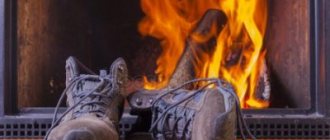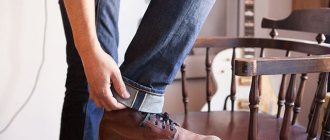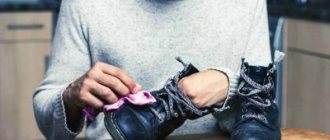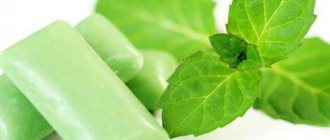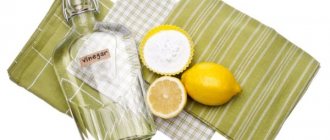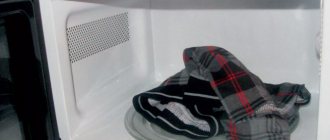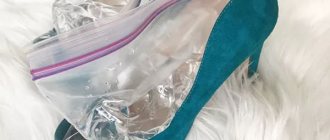Suede shoes always look very attractive. This type of shoe is chosen by people with a subtle sense of style and original taste. However, some are still afraid to purchase shoes or boots made of suede, since it is generally known that this is a very capricious material that requires constant care. Experts advise not to deny yourself the pleasure of wearing a beautiful thing by studying the basic rules for caring for suede shoes. In particular, suede boots need to be dried properly so that the material does not lose its elasticity and softness.
Scheme for drying wet shoes
Wet shoes threaten not only a runny nose, but also damage to the pair itself. To ensure that your favorite boots serve you for many years, take immediate action. It doesn’t matter what material your shoes are made of, almost all of them dry the same way. Particular attention should be paid to:
- thin suede;
- shoes with leather soles, which, in principle, do not tolerate moisture well.
Shoes that are soaking wet may require a little more drying time and more frequent padding.
Proper drying will extend the life of your shoes
Proper preparation of a pair of shoes
So what to do if your shoes get wet?
- Immediately upon arriving indoors (home or work), wet shoes should be removed. This must be done, otherwise it may become deformed. In such cases, keep a spare pair of shoes at work.
- If there is dirt, remove it with a damp cloth, including from inside the product. If you have suede boots or shoes, you first need to dry them and then clean off any remaining dirt.
- Take out the insoles, insulation, remove laces and all possible accessories, open the shoes as far as possible.
- Remember that drying is best done in areas with good ventilation.
- Drying wet shoes near or directly on radiators, heaters, or other heat sources is prohibited! The material may crack, deform, turn yellow, and the sole may peel off.
Any shoes, except for unpretentious rubber boots and summer flip-flops, cannot be dried on the radiator!
Talc
If a greasy stain appears on the surface of boots, sneakers or other suede shoes, or the shoes begin to shine, you need to thoroughly sprinkle the shiny areas with body talcum powder or baby powder. After that, the shoes should stand for several hours; after this period of time, you need to clean them with a stiff wire brush. In addition, you will need to treat the boots with soap foam to avoid the appearance of white spots. After this cleaning process, suede products must be dried for at least 12 hours.
How to dry shoes at home
The issue of drying is especially relevant during the rainy and snowy seasons. It would seem that there is nothing difficult to dry a pair of boots at home. Unfortunately, not everyone knows how to do this correctly, quickly and efficiently. The method and time for drying shoes depends on the material of the product, otherwise its structure can be damaged.
Rubber products
The simplest and most rewarding shoes to dry are rubber boots and summer flip-flops. They can be dried on a radiator without harm. If the radiator is too hot, first place a towel or board on it, and wet shoes on top.
Before drying rubber boots, remove the insulation from them (if any).
Rubber shoes can be dried on a central heating radiator, since they do not have elements that could be deformed under the influence of such heat
Drying sneakers and sneakers
Wet sports shoes can be dried in a dryer or washing machine on the dry setting. However this works if:
- this function is indicated on labels and in product care recommendations;
- you are confident in the quality of the shoes;
- the model is made of cotton or synthetics;
- The sole is made of soft materials or has a gel filler.
Inexpensive sneakers or sneakers can become damaged after washing or drying them in the machine.
Still, machine drying is one of the fastest ways. If you decide to use it, follow the following tips.
- Place a few old towels or rags, preferably cotton ones, into the machine drum.
- Be sure to unlace your shoes.
- Set the operating time to 60 minutes.
Before drying your sneakers or sneakers, don’t forget to unlace them and add a few cotton items to the machine.
Light, white sneakers or sneakers, as well as shoes with white soles, should be thoroughly blotted with a highly absorbent material, such as an old terry towel, before any drying. By removing as much moisture as possible, you will prevent streaks and yellowing of your shoes.
How to dry shoes with leather soles after rain
Shoes with leather soles are not called “office shoes” for nothing. It is intended exclusively for indoor wear. However, if your shoes get wet after rain, try to take them off as soon as possible. If worn wet for a long time, they may become deformed. You need to dry them by providing air access directly to the sole - just lay the shoes on their side.
Suede boots
Drying such shoes at home should be especially careful. Do not place it near heating appliances. Let dry naturally at room temperature. After this, remove any dirt from them.
You should clean suede shoes only after the fabric has completely dried. Otherwise, you will contaminate it even more, then after drying the boots you will also have to wash them
General recommendations
Whatever technique is chosen, it is important to consider the properties of the material from which your shoes are made. For example:
- Leather shoes should be dried using special spacer inserts.
- Suede products require delicate drying with paper or other adsorbents.
- Rubber boots are not afraid of drying on the radiator, but if the temperature is too high, place a board, cardboard or cloth under them.
- Spots and stains may appear on white sneakers. To avoid this, it is advisable to blot them with a terry towel.
To dry shoes, it is recommended to choose a cool, well-ventilated room.
The use of waterproof and water-repellent products, such as creams, gels and sprays, will once again avoid getting your shoes wet and the need to dry them.
We have full articles with recommendations on how to wash white sneakers and how to wash shoes in a washing machine.
How to dry shoes from the inside
When drying shoes, it is important to remember that the main work should be aimed at drying the product from the inside, and not from the outside. There are different drying methods, including express methods.
Paper for the night
The most popular “home” drying method is using paper. To use it, follow the instructions.
- Prepared shoes should be tightly stuffed with old newspapers or soft paper, after tearing them into small pieces.
- Newspapers can only be used for dark-colored shoes, as words and paint stains may be imprinted on light-colored ones. But even for a pair of dark-colored shoes, try not to use newspaper pages with large photographs and excessive amounts of ink, otherwise, after drying, you can stain the tights and socks with paint. For light-colored shoes, it is better to use toilet paper.
- If you are drying shoes made of genuine leather, do not stuff them too much. When wet, this material is very plastic, so it can stretch.
- After an hour, change the layer of paper to dry. Repeat as many times as necessary to completely dry the product.
If the shoes are wet through, except for the inner layer, wrap them on top with paper, securing them with a paper clip or rubber band. Change the “wrapper” as the paper gets wet, about once every half hour to hour.
The most popular home remedy for drying shoes is paper or newspapers.
This method is suitable for any type of shoes, even thin suede and membrane ones. The drying process takes a significant part of the time, as it occurs under natural conditions and at room temperature. Most often this method is used at night.
How long to dry rice
Rice grains absorb moisture well. It only takes 2 hours for your shoes to dry completely.
- Take a cardboard box. You can use shoe packaging, as long as it has a lid.
- Spread a thin layer of rice on the bottom.
- Open the shoe as far as possible and place it on the rump so that the sole is at the top.
- Close the box tightly and leave for 2 hours.
Rice absorbs moisture well
How to use silica gel
Another excellent absorbent is silica gel. Special drying bags can be purchased at the store, or you can make your own from a bandage and cat litter. The bandage can be replaced with gauze, or better yet, with a cotton sock.
- Place the bags into the prepared pair of shoes.
- After an hour, check that the product should be dry. To speed up the drying of wet shoes, the filler can be preheated on a radiator.
- After use, place the bags on the radiator again to dry. They can be used repeatedly.
Silica gel shoe drying bags are convenient to keep at work
Dry at home using a hairdryer, fan, vacuum cleaner
The most obvious “technical” way is to dry your shoes with a hairdryer. The method is suitable if it is not very wet, since you can only use the “cold air” mode for drying. Under the influence of a hot stream, the product may become deformed.
You can dry your shoes with a hairdryer only on cold blowing mode.
With a vacuum cleaner, the drying process is different. Here you do not need to pull moisture out of the shoes, but dry them with warm air. To do this, put the vacuum cleaner on blower and place the hose inside the product. This method is convenient for drying boots, especially tall ones.
If you switch the vacuum cleaner to blowing, you can dry wet shoes in just 15 minutes
Most tips for fan drying shoes suggest first making hooks from wire to hang the pair directly on the fan. However, it can be made simpler, because the principle is based on the fact that a strong flow of air, even cold, blows into the shoes and thereby removes moisture from them. So, you need:
- Prepare your shoes, open them as much as possible and place them against the wall or closet.
- Place the fan opposite. The distance should be about 30 cm, medium mode.
- One to two hours should be enough to completely dry your shoes.
Fan drying can be a godsend if you got your shoes wet before work. After all, it is in almost every office.
Can I use a microwave or oven
Microwave or oven drying is only recommended if you want to experiment and don't mind your shoes. The method is quite tough, there is almost a 100% chance that you will ruin the shoes (crack, soles will come off, etc.)
Do not use a microwave oven to dry shoes, otherwise you risk damaging them.
How to replace the battery
The “warm floor” system will also serve you well in drying shoes. The heating temperature is low and will not ruin your favorite boots or ballet flats, however, the method is quite long - the shoes dry approximately overnight - 8-10 hours.
By laying a warm floor in the hallway, you will forever solve the problem of drying shoes
Making a dryer with your own hands - video
Electric dryers - we use modern technologies
Do you want to dry your shoes as easily as possible? Use special dryers. They are very diverse in quality and price. They are available in three varieties:
- liner dryers;
- blow dryers;
- ultraviolet dryers.
Tack-on dryers will replace the washing machine
The most common and quite effective model of drying tool. It consists of two plastic parts, inside of which there are heating elements. It is placed in shoes for 3–4 hours. Insert dryers are quite safe for any type of product, the only thing is to buy high-quality models without protruding wires.
Dryer-liner - the most affordable special means for drying shoes
Fan dryers
Despite their large dimensions, blow dryers are universal - you can use them to dry gloves and hats, which is especially important if you have children. The wet item is placed on special ledges, the desired mode is turned on, and soon (the waiting time depends on the material of the item being dried and the selected mode) you will receive a completely dry item.
Fan dryers, of course, are more expensive than liners, and it depends only on you (namely, on proper operation) whether it is safe to dry shoes on them. If you decide to purchase such a device, pay attention to the blowing modes - it’s convenient when there are several of them.
A blow dryer can be used to dry not only shoes, but also gloves, hats, mittens, and socks.
Ultraviolet dryers
The most expensive device for drying shoes today. With its help you can not only dry the product, but also get rid of fungus. This dryer works both from the mains and from the battery.
An ultraviolet dryer will not only dry your shoes, but also get rid of fungus.
Choosing a shoe dryer - video
Fast drying method
Using salt as an absorbent will help you out when you need to dry your shoes very quickly. For this you will need:
- kitchen stove;
- pan;
- salt;
- a pair of socks (preferably thin ones, for example, nylon ones).
Prepare all the necessary ingredients and follow the further instructions.
- Sprinkle salt into the pan in a thin layer.
- After heating, pour it into a sock and tie it so that the absorbent does not spill.
- Place the resulting “dryer” into the wet shoes.
- Once the salt has cooled, repeat the cycle. It is possible that this will not be necessary, since the salt absorbent instantly absorbs moisture.
Ordinary table salt will help you out if you need to quickly dry your shoes.
If you get wet while hiking
It happens that drying is required not at home or at work. For example, you went on a hike and your shoes got wet, but there is no replacement pair. There are methods for “field” drying shoes.
- Hammer a couple of pegs near the fire. The distance to the fire should be about half a meter.
- Remove the insoles and insulation (if any) from the shoes and stuff them with paper or dry grass.
- Hang boots or shoes on pegs.
Another drying method is warm coals from a fire. You need to take out the insole, place the coals in the sock and put it in your shoes. This method is risky as the coals can burn your sock or stain your shoes.
To dry shoes that get wet while hiking, you can use natural absorbents. For this:
- remove the insoles from the shoes;
- fill boots or shoes with dry hay or dry stems, such as oats;
- After an hour, change the layer. Repeat until the product is completely dry, usually 2-3 changes are enough.
General rules
Drying fabric or leather shoes is not difficult if you know the basic rules and apply them in practice.
These include:
The wet leather upper is easily exposed to external influences. Because of this, even when slightly wet, special attention must be paid to drying. If your feet get wet in the rain, you should try to take off your shoes as quickly as possible.- Moisture is removed with a soft cloth from the outside and inside; if there is water inside, it is drained.
- Drying should be done in a well-ventilated area.
- It is necessary to take into account the materials that were used for production.
The sooner you start drying wet shoes, the better the result.


